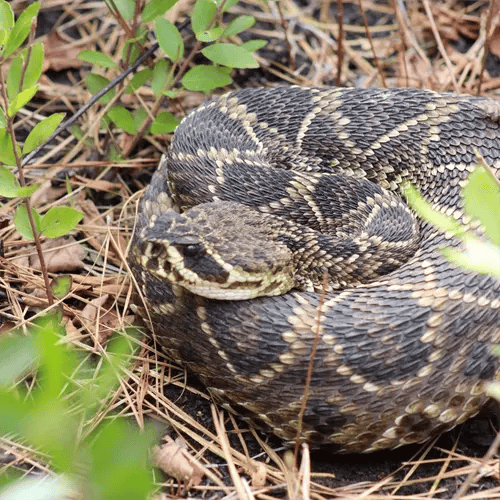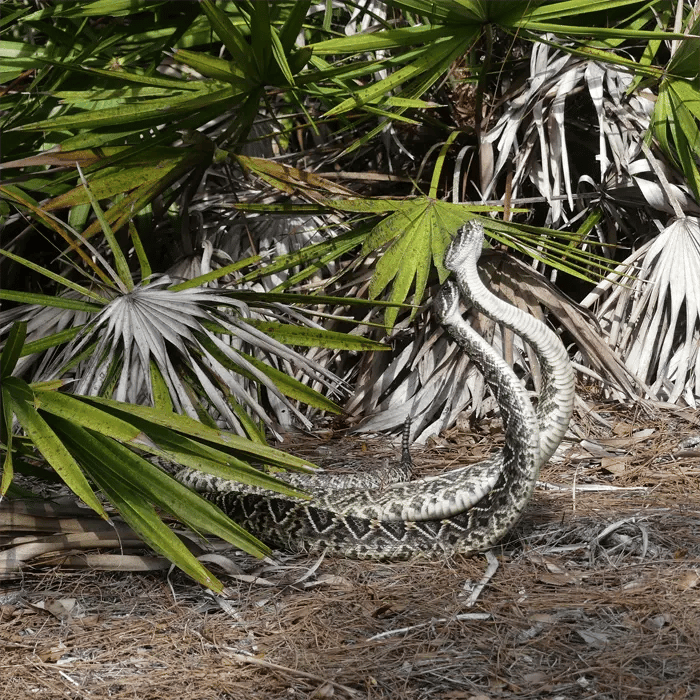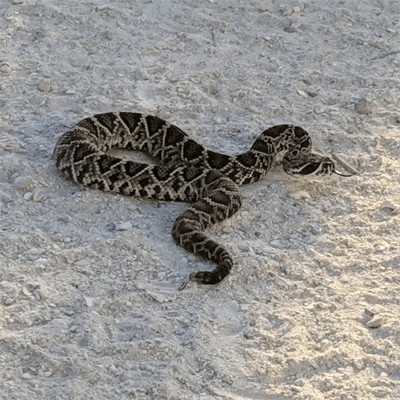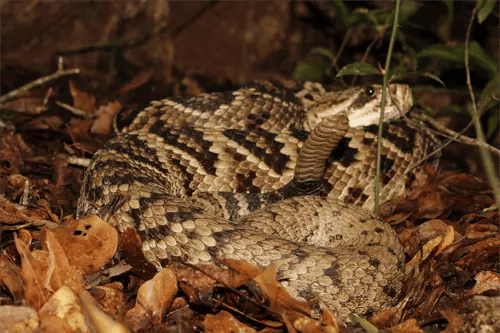Eastern Diamondback Rattlesnake
- Scientific Name
- Crotalus adamanteus
- Also Known As
- Eastern Diamond-backed Rattlesnake
- Range
- All of Florida
- Diet
- Small Mammals, Birds, Snakes, Insects
- Life Expectancy
- 10 Years
Quick Links
Eastern Diamondback Rattlesnakes in Central Florida
The eastern diamondback rattlesnake (Crotalus adamanteus) is a venomous pit viper species found throughout the southeastern United States, including the central Florida region. This impressive snake is the largest rattlesnake in the world, capable of reaching over 8 feet (2.4 m) in length.
Eastern diamondbacks thrive in the warm, humid environment of central Florida and can be encountered in sandy pinewoods, scrub, palmetto flatwoods and swamps. Read on to learn identification tips, biology, behavior, diet, health risks, and prevention methods for eastern diamondback rattlesnakes in central Florida.
Appearance and Identification
The eastern diamondback rattlesnake can be identified by the following characteristics
The eastern diamondback can be distinguished from other rattlesnake species in Florida like the pygmy rattlesnake, dusky pigmy rattlesnake, and timber rattlesnake based on size, color patterns, scales, facial characteristics, and rattle features.
It is much larger than pygmy and dusky pygmy rattlesnakes, reaching over 8 feet long compared to their 2-3 foot maximum size. It has distinctive diamond-shaped dorsal blotches outlined in lighter colors, while pygmy rattlesnakes have a solid dorsal stripe. The eastern diamondback’s triangular head is also larger than other species, and its rattle produces a notably louder buzzing sound used for signaling.
Maturation Rate
Newborn eastern diamondbacks average 14-22 inches long. By their first year, they reach 2 feet (60 cm) long and attain 3 feet (around 1 meter) by age two. Maximum size is achieved by 4-5 years old in males and 7-8 years old in females. After reaching adulthood, eastern diamondbacks grow about 4 inches (10 cm) per year up until maximum length.
Habits and Behavior
Eastern diamondbacks are generally solitary, terrestrial snakes that are active during the day (diurnal) and evening (crepuscular). They spend a significant amount of time basking in sunny openings and move between dry ridges and wet, lowland swamps when hunting.
During the hottest summer months, eastern diamondbacks become more nocturnal and can be found on roads at night. They are ambush predators that use camouflage to hide along game trails, remaining coiled and still until prey comes near. The rattle is used as a warning signal when threatened. Despite being venomous, eastern diamondbacks generally avoid confrontation if given an escape route.
Reproduction and Lifespan
Eastern diamondbacks sexually mature between 2 to 4 years of age. Males engage in ritual combat dances during the breeding season from April to June. After mating, females give birth to 5-21 live young about 5-6 months later from August to October.
Young eastern diamondbacks are independent immediately after birth. They shed their skin frequently as juveniles when growing. Adults shed 2-4 times per year. Their average lifespan in the wild is around 10 years.
Ideal Habitat and Range
The warm, humid climate of central Florida provides ideal habitat for the eastern diamondback rattlesnake. Average annual temperatures range from the mid 60s°F (18°C) in northern counties to the mid 70s°F (24°C) in southern areas. Hot summers see highs in the 90s°F (30s°C).
Central Florida receives abundant rainfall of 40-60 inches (1000 to 1500 mm) per year, supporting dense forests and swamps. Palmetto flatwoods, pine forests, scrublands and coastal dunes offer the dry, sunny openings preferred by eastern diamondbacks along with wooded wetlands for foraging. The high biodiversity supplies a prey base of small mammals, birds, amphibians, and other reptiles.
Diet and Feeding
Eastern diamondbacks prey upon a variety of small animals, ambushing them from camouflaged positions:
- Small mammals: Squirrels, rats, mice, rabbits, moles, shrews, etc. Most important food source.
- Birds: Quail, grouse, songbirds attracted to ground scratching for seeds.
- Amphibians: Frogs, toads, salamanders.
- Other reptiles: Snakes, small alligators, lizards.
- Invertebrates: Large centipedes, caterpillars and beetle larvae provide moisture.
Neonates and juveniles eat smaller prey like reptiles, amphibians, rodents and invertebrates. Adults take larger warm-blooded prey. After striking, they release and track the scent trail of envenomated prey which soon dies. Eastern diamondbacks go through periods of fasting between major meals.

Photo 34056215 © mrsbbannon, CC BY-NC

Common Health Risks
Eastern diamondback rattlesnake bites can inflict severe tissue damage and major systemic effects from cytotoxic venom components:
- Hemotoxic – Affects circulatory system and blood cells leading to coagulation issues.
- Neurotoxic – Impacts nervous system through pre-synaptic neurotoxins. Causes muscle paralysis.
- Myotoxic – Breaks down muscle tissue causing pain, swelling, necrosis.
- Edema-inducing – Damages blood vessels and causes fluid leakage.
Without antivenom treatment, eastern diamondback bites can be fatal. With treatment, mortality rate is around 3-4%. Bites often cause permanent tissue loss. Other symptoms include intense pain, bruising, blistering, necrosis, vomiting, tingling and numbness.
Preventing Eastern Diamondback Rattlesnake Encounters
The risk of conflict can be minimized by learning identification, making noise when hiking through brush, wearing snake-proof leg wear and boots in snake country, and always giving snakes a wide berth if encountered and allowing them to retreat.
Around homes and yards, keep vegetation short, remove woodpiles and debris they can hide under, install snake-deterrent fencing, and keep pets from roaming unsupervised. Trapping and removal of eastern diamondbacks should only be conducted by trained professionals due to safety risks.
Florida Water Rats in Central Florida – Conclusion
As Florida’s largest and most dangerous native venomous snake, eastern diamondbacks demand caution and respect from residents and visitors to the region. Their cryptic habits, potent hemotoxic venom, large size, and abundance in central Florida’s wilderness areas make accidental encounters a risk.
However, through education and preventative yard maintenance, problems with eastern diamondbacks can often be avoided. If bitten, immediately seek emergency medical care for antivenom administration and rapid treatment.








